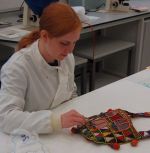Nigerian Dance Sash
 Treatment Report: GLAHM E.1983.71 Dance Sash with name by Beatrice Farmer, 2nd Year student, MPhil Textile Conservation, University of Glasgow (2012).
Treatment Report: GLAHM E.1983.71 Dance Sash with name by Beatrice Farmer, 2nd Year student, MPhil Textile Conservation, University of Glasgow (2012).
"During my degree I was given the opportunity to conserve this 20th century Nigerian Dance Sash from the Hunterian Museum collection. The front is covered in small glass beads, whilst the back is lined in a red cotton fabric. The beads were in very good condition, though quite dirty. The lining fabric was very dirty, creased and damaged. It was my role to repair the damage so that the object could be preserved and appreciated by museum visitors.
During discussions with the Curator, Sally-Anne Coupar, it was suggested that the dirt on the textile could have originated from its previous use in dance ceremonies, when body paint and sweat could have soiled the object. It was important, therefore, to preserve this evidence of previous use.
The glass beads were cleaned using water, because it was thought that the dirt present in this area primarily originated from museum storage. The textile lining was humidified to relax the creases using cold water and Goretex® in a very slow and gentle manner. It was then supported using a cotton fabric dyed specially to blend in with the original. Nylon net was also used to protect the outer surface of the fragile textile. Extensive stitching secured these layers of fabric together, with the most challenging aspect being to keep the tension even. Nylon net was also placed over the smaller area of damage on the strap, which allows the interesting construction stitching to be viewed while still protecting the weak area.
The practical aspect of carrying out such treatments as well as the engaging theoretical debates is what most attracts me to the course. I hope to utilise what I have learnt by pursuing a career in textile conservation, which could involve working in a museum or in private practice".

